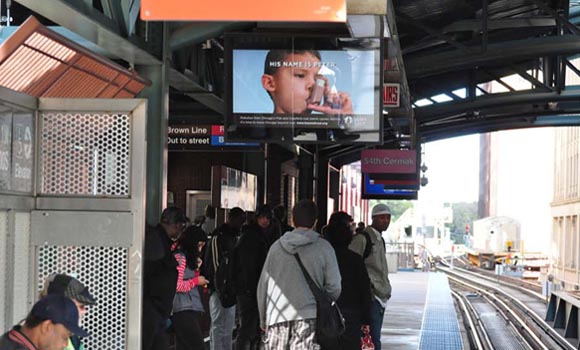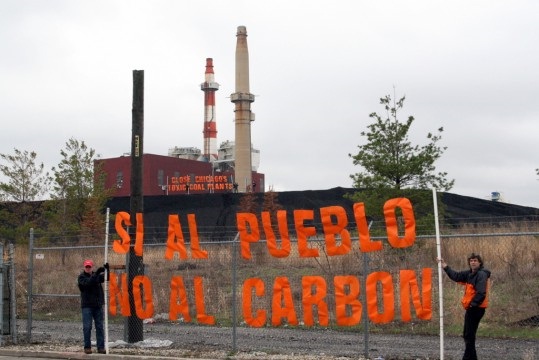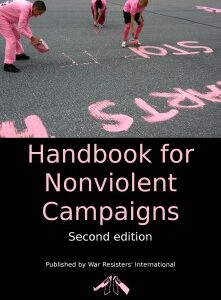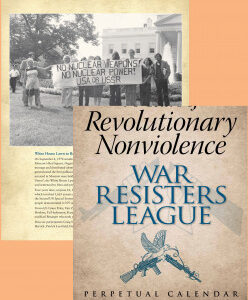No al carbón: Environmental Racism in Chicago

The Little Village Environmental Justice Organization (LVEJO) was recently victorious in a decade-long campaign to shut down two coal-fired power plants in Little Village, a Latino neighborhood in Chicago’s South Side. LVEJO has a variety of programs, such as its now-notorious “toxic tours” of the worst polluters in the community. The organization and staff, almost all born and raised in Little Village, truly embody an intersectional approach that understands the deep roots of environmental justice issues as well as the byproducts of environmental racism in the daily life of a struggling community.
In this discussion, Rafael Hurtado, an organizer with LVEJO’s Clean Power campaign and lifelong Little Village resident, talks about the tactics that led to a winning campaign and the connections between race, poverty, and the environment.
Alex Cachinero-Gorman (ACG): Could you begin by briefly describing LVEJO’s work?
Rafael Hurtado (RH): LVEJO is going on 16 years, and basically what we do is work on environmental issues in the com- munity. We’re more of an organization to go after the root of the problem than attack the symptoms, so that’s why our campaigns are really strong, yet long campaigns. Plus they all correlate with one another. Even though they might sound different — from our Urban Agriculture to our More Parks campaign, from Clean Power to the 31st Street Bus — each has a different agenda, but they all complement one another because they are addressing the same lack.
ACG: And what is LVEJO’s history in the community?
RH: LVEJO started at Gary Elementary School in 1994. At that time they were refurbishing windows and re-tarring the roof—but this was an old building with no air conditioning in the middle of summer school in Chicago. They were doing this work and kids were having asthma attacks, fainting, being exposed to lead poisoning. It was ridiculous. And it wouldn’t happen in any other neighborhood. In the end the parents organized and succeeded in getting the work moved to the night time when the kids weren’t around. It began to empower parents and community members and was the first time that parents said, “if we can take on these issues, what else can we take on?” And from there, the organization was formed, originally calling itself the Little Village Environmental Justice Project, LVEJP.
ACG: From small beginnings you have grown a lot over the years. Now you’ve garnered national attention with your Clean Power campaign, after your victory in shutting down two coal plants just a few weeks ago. Can you tell me a little bit about when the campaign started and what the targets were?
RH: It was a very long campaign. Clean Power was over a decade long, beginning in 2001. It was in 2001 that the Harvard School of Public Health came out to do a study on Chicago’s air quality, and they pointed out this simple fact: two coal plants, three miles apart, there’s your problem. All these things started coming out from their study: 42 premature deaths a year, 550 emergency room visits, 1800 asthma attacks per year. And what’s to say that, 10 years later, it wouldn’t have gotten even worse?
So that was what gave us a platform. The two coal plants were the Crawford Generating Station in Little Village, and Fisk in Pilsen. Both have been shut down since the end of August. They were managed by Midwest Generations, a subsidiary of Edison International.
ACG: And what was the main message of the campaign?
RH: A coal plant is a big “polluting industry welcome” sign for a community. No jobs are created for the neighborhood through it, because they just don’t hire people from the neighborhood. We don’t get jobs, we’re not getting some kind of discount from our bills, our electricity isn’t even coming from them.
ACG: Can you explain that?
RH: The power doesn’t stay in the community. The power doesn’t even stay in the state. We started figuring out how they make money off coal—as soon as it crosses state boundaries, it’s taxable. You give me some coal, I’ll give you some power, we got money in our pockets at the end of the day. The power all goes to the East Coast. We just get the pollution.
So we’re getting all these health issues and the plant isn’t even an asset to this community.
ACG: What was it that happened in the last year or so that really pushed the campaign to victory?
RH: I would say even back in about August of ’09, when the court battle started, things changed. Once we got these fools into court, the campaign was won. All you have to do is get attention and people will say, “These people are inhumane, they need to be shut down.”
ACG: There was also a very visible media campaign involving billboards all over the city that got a lot of attention.
RH: With Pete? That was his name, that kid. Well, a lot of people have asthma. Just one of the perks of living in the shadows of a coal plant. The billboards hit home — he’s a kid, you see him in the face of any relative, any neighbor, any friend you ever saw, any child you ever saw. And, although the plants are in low-income communities of color, to see this picture all around the city it gives you a sense of humbleness. People started figuring out the con- tamination wasn’t necessarily just contained in Little Village and Pilsen. That really pushed other communities and organizations to get on board. So we created the Clean Power Coalition, which was comprised of a lot of different groups, including the PERRO [Pilsen Environmental Rights and Reform Organization], Sierra Club, Greenpeace… it’s a long list. We gained a lot of allies.

ACG: Was there any relationship in particular that you saw as key to success?
RH: It was when we partnered with Keepers of the Mountains, an anti-mountaintop removal organization from Appalachia, Kentucky, that we really started seeing the connections between our communities. I was down there in Atlanta and they came to our workshop at the US Social Forum. They told us, “We like the work you do, but you should check out what we’re doing in our neck of the woods.” Low-income white people — “endangered hillbillies”, they called themselves. (laughs) They’re humble.
They had home videos of them eating dinner with the family and the whole house rattles—they had bombs more powerful than in Oklahoma City going off like 300 feet away from homes. They showed us this stuff, and I was like “Holy shit. How is this happening in the United States?” That’s when I realized, this isn’t about your skin color — it’s all about the resources and the money you have. It’s all about the path of least resistance for corporations. From there our organizer at that time was like, if they call their organizing base “the Holler,” we gotta start from here, “the Hood.”
So that helped bring attention to our campaign. Because basi- cally, by working with them, we were able to show coal from the cradle to the grave — from where it’s dug, to where it’s burned, and the effects along the way.
ACG: And there were some pretty notable direct actions that followed, too, as I understand.
RH: There were several actions — one of the actions that brought a lot of attention was the “Coal Olympics.” That was around the same time that Chicago was bidding for the Olympics that Rio ended up getting. We were mocking the mayor — as in, “how dare you bring these world renowned athletes to Chicago with these two coal plants here?” You know, he wants to make himself the greenest mayor in the history of the U.S. and yet he has these two plants? What is that? We had a relay race where you jumped over hurdles of coal and paper mâché mountains to take the golden inhaler out, and run back. (laughs) A lot of people came. That’s when we started tying stuff in with the Big Greens — like Greenpeace and Sierra Club.
There was another action where the Greenpeace people came in and put a huge banner in front of Crawford, and meanwhile they got people jumping off the bridge off the Sanitary Canal. They tied ropes to themselves and jumped off and stopped the barges from coming in. People got arrested. At the same time, there were people from Greenpeace at the Fisk site shimmying up the coal stack writing “Coal Kills” on the stacks. But Greenpeace, you know, they have money — bail money — and people willing to do that kind of stuff.

ACG: It seems like direct action is always delicate, tacti- cally speaking. What did you see as LVEJO’s role in relation to other environmental groups, in that sense?
RH: When you’re dealing with different characters in a coalition, everybody needs to know what everyone wants. When you’re on the same page, it’s easier to add people to the coalition. And when it comes to actions, there are gonna be those groups that want to flex their activist muscles. Which is cool, because we don’t have people in the community who will tie a rope to themselves and throw themselves off a bridge. So by all means do that. We’ll get people together to support you and continue organizing in our community.
ACG: What’s going to happen to the property now? How are you going about follow-up?
RH: Well, there’s a community side and a corporate side. The corporation wants redevelopment and remediation, as in, who is going to fix and clean up the site? Because we know they’re going to cut corners and try to be cheap. So what they want to do is figure out the end user first; whoever gets it cleans it up to their standards.
Whereas the community wants remediation for redevelopment. Fuck who comes in next. Clean it up first, then deal with whoever comes in.
ACG: Have there been any proposals for what to put on the site once it’s cleaned up?
RH: Through community meetings, a lot of people have sug- gested a junior college or a trade school. The scary thing is, his- tory repeats itself in many ways. There was a trade school called Washburn in the community, but there was political and corporate influence to shut it down, primarily from the coal plants! Because God forbid you have these colored, low income people educating themselves to go work in the coal plant to displace these wealthier white men, you know?
The biggest and most popular idea has been a bike path by the river walkway. It would be our access to the canal, but most importantly a scenic route.
The thing is, the way the city has the laws, the land can’t be for one single use. You have to incorporate commerce, industry, and green space. So the community said okay, in that case: no big box; for industry, obviously living wages and no polluters; and for green spaces, not necessarily a park (which we just won on the east side), but a scenic route.
ACG: I wanted to go back to something you said earlier. You said color doesn’t matter, because capital will move into a community regardless of who or what is there if it sees a profit. At the same time, there are definitely patterns to what communities get affected more than others. In this sense, how do you see LVEJO’s work in relation to the larger environmental movement which often shuts out communities of color?
RH: The way I see it — we have to see this as an historic win on a national level. But the truth is, everybody knows about it except the people in the neighborhood. Why? Because the media and the corporations don’t want to give our people credit, so they don’t cover the story. Because that would be empowerment and momentum, something we could use to continue and expand our work.
I went to DC in June and when they introduced me people knew who I was — I was shocked. I was like, how come people from the block don’t know what we do? This story is getting attention everywhere except for Chicago. Why? Because we are setting the bar for the rest of the country. ‘Cause not only did we get it shutdown, but we are moving fast. And we have [Mayor] Rahm [Emanuel] making a task force to deal with it and he is looking to be president — and people know it.
The other thing is that the company voluntarily shut down in the end. It could’ve gone another way: There was a city ordi- nance in the works to regulate coal plants, but it didn’t pass. If it had passed, it would have set a new precedent. Think about it. So many other cities would have taken notice and organizations would try to get ordinances passed in their cities. And why is that significant? Well, 30% of Latinos in the country live seven miles or less from a coal plant. People don’t know this. But that ordinance would really create a ripple effect in communities of color across the U.S.
ACG: The theme for this issue of WIN is “land.” How do you see LVEJO’s work connected to larger issues of sustain- ability, sovereignty, and territory?
RH: It’s very simple, because it’s all about taking back your land—it’s your community, you should have a say in what goes on. The way we look at it, we always ask: who’s coming into our neighborhood and taking our land, which should be used for our parks, our libraries. Taking it and not even giving back, but making a profit? So land, as a framework, is key.
Alex Cachinero-Gorman is a freelance journalist, translator, and interpreter currently based in Chicago. He is a participant in the Decolonial Translation and Tlaxcala International collectives and was a co-founder of Intercontinental Cry Español. His website is LosArtilugios.org.

 Handbook for Nonviolent Campaigns, 2nd Edition
Handbook for Nonviolent Campaigns, 2nd Edition  WRL Perpetual Calendar
WRL Perpetual Calendar